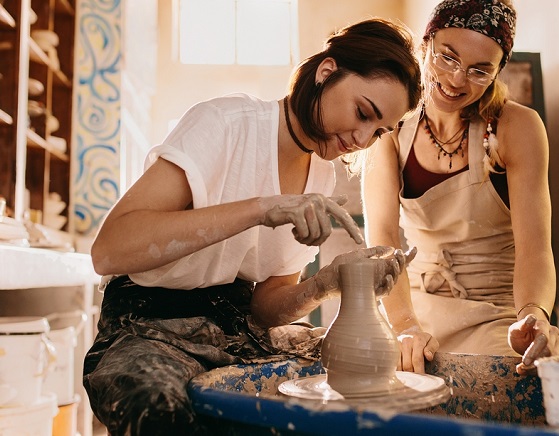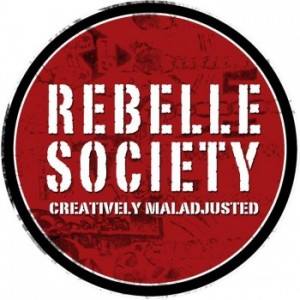Sung Home: Chapter Fifty. {fiction}

The next part of our tour took us through a series of metal warehouses that completely surrounded the greenhouse building.
The entire complex, not including the residential building to the north, took up two full blocks.
We moved into a hallway that connected the greenhouse to the warehouses. The long hall was dotted periodically with doorways.
The first few of the rooms we explored held a variety of 3D printers for making pretty much anything one could imagine — clothing, tables, chairs, game pieces and boards, dining utensils, pots and pans.
“We never worry about not having enough. Anything we’re not using can just be put in a hopper and reprocessed and put through a printer again. We have virtually no waste,” explained Robert. “We could use more raw materials, but the Slavers make it hard to get out and scavenge the houses and the dumps.”
One room held large tables with sewing machines, and looms of various sizes. The walls in this room were lined with plastic utility shelves containing bolts of fabric, colorful bunches of yarn, knitting and crochet needles, and other implements of fabric arts and crafts.
Two people sat side by side, spinning some kind of fluffy fiber into yarn on old-fashioned spinning wheels. A man was sewing while a woman pedaled a stationary bicycle next to him, while the two chatted.
“The bicycle generates electricity for the sewing machine,” Robert explained. I then noticed the wires and gadgets connecting them both.
Another room contained a giant kitchen and pantry, where all the food was processed for storage and prepared for meals. There was a woodworking room that reminded me of Hallie’s shop, except much bigger. A clay studio, complete with foot-powered potter’s wheels. A glass-blowing studio. An old-fashioned blacksmith’s forge.
“The people who started this place actually set up most of this before the virus hit. They knew that the systems people were dependent upon weren’t going to last, though I guess they had a lot of different theories about why. A monster virus wasn’t anywhere near the top of the list.”
I had a hard time taking in the scope of everything we were seeing, and judging from Victorio’s face, wide-eyed and slightly slack-jawed, he was experiencing something similar.
“I know it’s a lot to absorb at first,” said Robert, “but you get used to it after a while.” He continued, “Still, you know, I’ve never really been able to get used to living in town, basically in a prison, since it’s so dangerous to leave. I miss the sky and the air, working outdoors.”
“The Slavers are a pretty big problem, eh?” said Victorio.
“Yeah, but we also have a chemistry lab, and our chemists, the ones who came up with the sedative for the blow guns we used the other night on the Slavers, have some ideas.”
“Sedative? I thought it was poison! You mean they weren’t killed? What happened to them?” I asked. As much as I hated the Slavers, I felt a little relieved. Mass killing, however justified, wasn’t something I was ever going to feel great about.
“Well…” Robert hesitated, “Actually, they’ve all been taken to drug rehab.”
“Drug rehab?” asked Victorio, shaking his head in puzzlement, “you mean, to get them off drugs? I didn’t think there were enough drugs left to be a problem.”
“No. Not to get them off drugs. They use drugs to help them. I don’t know that much about it. I should take you to Nola. She can explain it better than I can.”
This place seemed more wonderful, and baffling, by the moment. Soon we were back near the infirmary, at Nola’s office.
“Oh my god, no, of course we didn’t kill them,” Nola exclaimed. “Well, I can’t say we’ve never killed anyone, the Slavers, but only in self-defense, when there was no other practical alternative. No, no, what we do here, or attempt to do, with varying levels of success, is rehabilitate them. People aren’t born being hateful and violent. They’re made that way.
And while some have been hard-wired for violence from such a young age that there’s not much we can do, most of them we can help to heal. At least, we’ve had some success with the few Slavers we’ve captured over the years. Now we have a big group, I think 18 of them, that was brought in from the raid yesterday. We’ve never tried it at once with so many, but we’re optimistic.”
“What do you do?” Victorio asked. I leaned forward on the table at which we sat, completely perplexed. What on earth was she talking about?
“Well, first we take them to the Secure Room, several rooms actually, inside another, completely surrounding room, inside another completely surrounding room. All locked,” Nola explained.
“A prison, you mean,” I said, raising my eyebrows. I didn’t know how much I was going to trust someone who spoke that way about what was basically imprisonment, having been a prisoner myself for so long. Not that I felt sorry for the Slavers, since I had accepted the idea that they had been killed. But I figure we should call things what they are and not kid ourselves.
Nola sighed, pursing her lips before continuing, “Yes, I suppose that’s one way to think of it. We don’t think of it as punishment, but keeping that person from hurting any of the rest of us. The Inner Sanctum is a large room, with several cubicles for privacy. They are all equipped with comfortable beds, tables, chairs, closets, an assortment of clothing, toilets and showers.
In addition to good food, we also bring them other things they might want, craft supplies, paper, etc. We leave books about the nature of trauma, violence, its causes and cures, for the ones that seem to know how to read. We talk to them every day through a window with two-way speakers, encouraging them to relax and to talk if they want.
The person often still resists, but their defenses weaken and they often have a kind of breakdown emotionally. Anger, crying, peace. If they stay peaceful for a few days or so, they are allowed into the next ring outward where they can interact more naturally with the others who are at a similar stage in their process.
Once we see they get along with those people for a while, then we see how they do out here with the rest of us.”
“It sounds like you’re kind of deprogramming them, like they used to with people who had joined cults or something, right?” ask Victorio.
“Kind of. Really, we’re all programmed in a sense. We all hold beliefs and attitudes in life. These beliefs determine how we see things around us and those perceptions determine our actions. So we are actually deprogramming them, then re-programming them in a way that fits well with our way of life, the culture that we have deliberately cultivated here,” Nola continued.
“But what’s the ‘drug rehab’ about?” I asked.
“That’s for the people who are more resistant, who don’t seem to be pulling out of their violent tendencies during the process I just described. Some people just need more help. The idea for our drug rehab process has its origins in some experiments done decades ago, using psychedelic drugs to help people heal from addiction and a variety of mental illnesses.
They actually made some good progress before some folks decided to distribute these substances willy-nilly and pretty soon they were made illegal.
Anyway, it’s a very carefully conceived protocol. We start by putting them in one of the rooms and seeing what they do in there, through one-way glass. Once they have stopped raging, we send in one of our specially trained rehab people. They have a small needle on a ring they wear, filled with a strong sedative, just in case.
They bring the person a drink they like, laced with some LSD-25, or DMT or MDMA, depending on the person, and sit down to talk with the them. When they start to come on to the drug, the therapist talks them through their experience, and holds a place of compassion and non-judgment for them. It’s pretty amazing what can happen.”
“You drug them?” I was shocked and horrified.
She eyed me levelly, “Countless cultures throughout time have used psychotropic plants for healing psychological wounds and for other reasons, like seeking spiritual or practical guidance, or for the exploration of consciousness. What we’re doing here isn’t new at all. We just use the substances we have access to.
We are growing peyote, ayuhuasca and chacruna, some of the plants used traditionally, but we don’t have enough to harvest just yet. But we do have a great chemist, so we use pharmaceuticals for now.”
I was opening my mouth to ask more questions about their drug rehab program, and what would ultimately happen to the Slavers they had captured, when Frank showed up.
“Hey there,” he exclaimed happily. Hugs were exchanged between Frank and me and Victorio. “I was hoping I could find you. It’s a pretty big place. I’m glad to see you both looking better. You feeling okay?”
“I’m okay, except for the bruises that’ll take a while to heal,” answered Victorio.
“Lots better,” I replied, nodding.
“Good, good! Let’s go talk.”
We thanked Nola for her time and headed off to the Common Room with Frank to find out what he, Ching Shih and the others had been planning.
“We should get going pretty soon. Like tomorrow morning. We dealt the Northern Slavers a pretty big blow, taking so many of their people, and releasing so many of their captives. The Makers don’t think the Southern Slavers have caught on to what’s happened. Apparently they’ve been keeping to themselves lately. But that could change at any time too.
We’re going to travel to the university to see the Uvies with some of the Makers, some of their scientists, because there’s several scientists at the university too, plus a much bigger, better stocked lab than they have here. They want to see if they can make up a large enough batch of sedative to dose the whole Northern Slaver complex.
They’ve been setting up a giant drug rehab place like they have here, to hold a lot of Slavers…”
“What does that have to do with us?” I asked.
“Well, nothing, except that we’re going to travel together, and soon, so we can get over there safely, and give you a chance to expand your book collection.”
This is an ongoing series from a forthcoming fiction novel by Laura Ramnarace.
Tune in weekly for the next chapter in ‘Sung Home’.
***

Laura Ramnarace, M.A. was driven to earn a master’s degree in Conflict Resolution while on her quest to find out why we can’t just all get along. She has published a book on inter-personal conflict, ‘Getting Along: The Wild, Wacky World of Human Relationship’, published a newspaper column also titled ‘Getting Along’, and submits regularly to Rebelle Society. Since 1999, she has provided training to a wide variety of groups on improving personal, working and inter-group relationships. ‘Sung Home‘ is a work of eco-fiction set in southwestern New Mexico.

